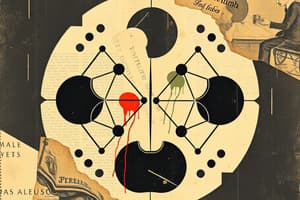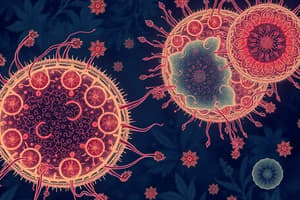Podcast
Questions and Answers
A cell in the kidney tubule is damaged but not beyond repair. In which phase would the cell most likely be found before potentially re-entering the cell cycle?
A cell in the kidney tubule is damaged but not beyond repair. In which phase would the cell most likely be found before potentially re-entering the cell cycle?
- G2 phase
- G0 phase (correct)
- M phase
- S phase
During which phase of mitosis do the chromosomes align along the equatorial plane of the cell?
During which phase of mitosis do the chromosomes align along the equatorial plane of the cell?
- Anaphase
- Metaphase (correct)
- Telophase
- Prophase
What is the primary function of the G1-S checkpoint in the cell cycle?
What is the primary function of the G1-S checkpoint in the cell cycle?
- To replicate DNA
- To assess DNA damage before replication (correct)
- To initiate cytokinesis
- To ensure proper alignment of chromosomes during metaphase
Which of the following cell types is permanently in the G0 phase?
Which of the following cell types is permanently in the G0 phase?
If a cell has 46 chromosomes during the G1 phase, how many chromosomes will it have after the S phase?
If a cell has 46 chromosomes during the G1 phase, how many chromosomes will it have after the S phase?
What is the role of cyclin-dependent kinases (CDKs) in cell cycle regulation?
What is the role of cyclin-dependent kinases (CDKs) in cell cycle regulation?
Which event occurs during prophase of mitosis?
Which event occurs during prophase of mitosis?
Following DNA replication in S phase, what is the ploidy of the cell before it enters mitosis?
Following DNA replication in S phase, what is the ploidy of the cell before it enters mitosis?
What is the process of cytokinesis responsible for?
What is the process of cytokinesis responsible for?
The activation of 'green genes' in the cell cycle directly leads to what?
The activation of 'green genes' in the cell cycle directly leads to what?
Flashcards
Cell Cycle
Cell Cycle
The series of events a cell undergoes to divide into two daughter cells.
S Phase
S Phase
The phase where DNA is replicated, doubling the chromosome number from 2n to 4n.
G1 Phase
G1 Phase
The first growth phase where the cell prepares for DNA replication.
G2 Phase
G2 Phase
Signup and view all the flashcards
M Phase
M Phase
Signup and view all the flashcards
G0 Phase
G0 Phase
Signup and view all the flashcards
Labile Cells
Labile Cells
Signup and view all the flashcards
Mitosis
Mitosis
Signup and view all the flashcards
Interphase
Interphase
Signup and view all the flashcards
G1-S Checkpoint
G1-S Checkpoint
Signup and view all the flashcards
Study Notes
- The cell cycle is the series of events a cell undergoes to divide into two cells.
S Phase
- DNA is replicated during this phase.
- Chromosome number goes from 2n (46) to 4n (92).
Pre-Synthetic Phase/Growth Phase 1/G1
- The cell prepares for DNA replication.
G2 Phase
- Post-synthetic but pre-mitotic phase.
- The cell prepares to divide replicated DNA into daughter cells.
M Phase (Mitosis)
- Separates chromatids.
G0 Phase/Rest Phase
- Some cells enter this phase instead of returning to G1 after division.
- Cells in G0 can re-enter the cell cycle later.
Cell Types Based on Division Activity
- Labile cells constantly multiply, e.g., skin and GIT cells.
- Stable cells enter G0, e.g., hepatocytes, kidney tubules, and pancreas cells.
- Permanent cells are permanently in G0, e.g., neurons, skeletal, and myocardial muscle cells.
Mitosis
- Division of nuclear material.
- Separates 92 chromosomes into 46 for each daughter cell.
Interphase
- Includes G1, S phase, and G2.
Stages of Mitosis
- Prophase: Chromatin condenses, chromosomes become visible, nuclear membrane dissolves, and centrioles move to opposite poles and nuclear membrane dissolves by phosphorylation of limenine proteins by enzymes.
- Metaphase: Microtubules form the mitotic spindle, chromosomes align on the metaphase plate, and microtubules attach to kinetochores.
- Anaphase: Chromosomes separate into single structures and move to the poles.
- Telophase: Nuclear membranes reassemble around two new groups of chromosomes and chromatin loosens.
Cytokinesis
- Organelles replicate.
- The cell membrane pinches, dividing the cytoplasm nearly equally between daughter cells.
Cell Cycle Checkpoints
- G1-S checkpoint: Checks for DNA mutations before S phase.
- G2-M checkpoint: Checks DNA again before mitosis.
- Mutations found at checkpoints prevent cell cycle progression until corrected.
- M-checkpoint: Some believe there's a checkpoint in metaphase to ensure proper alignment.
Control of Cell Cycle Progression
- Activated "green" genes facilitate the G1 to S phase transition.
- "Red" genes stimulate the replication of green genes.
- "Blue" genes inhibit green genes.
Red Gene Components and Function
- Growth factor (GF)
- Growth factor receptor (GF receptor)
- Responder
- Transcription factor (TF) gene
- Cyclin gene
- Cyclin-dependent kinase (CDK) gene
- Growth factor attaches to GF receptor, which signals the signal transducer to TF gene to create TF.
- TF activates the cyclin gene, producing cyclin.
- Cyclin binds to and activates inactive CDKs, forming a complex.
- The complex phosphorylates a protein holding a TF.
- Phosphorylation releases the TF, which transcribes green genes.
- Expression of green genes allows entry into S phase.
Studying That Suits You
Use AI to generate personalized quizzes and flashcards to suit your learning preferences.




